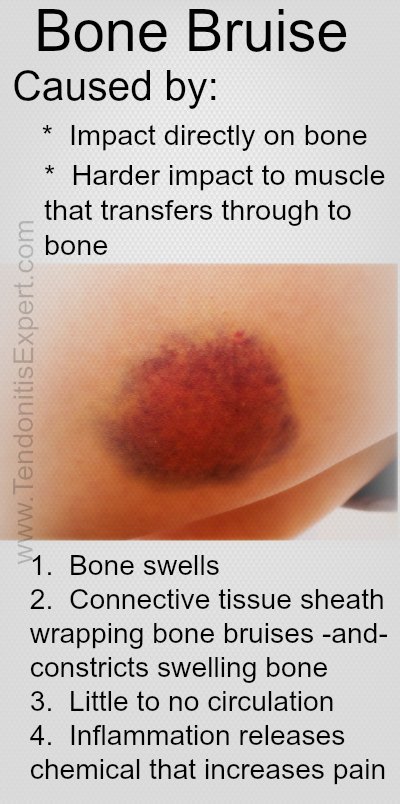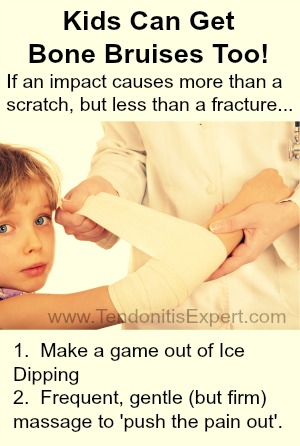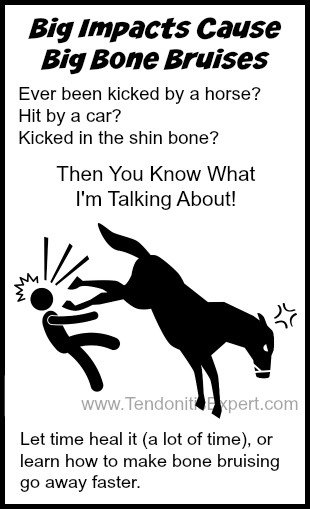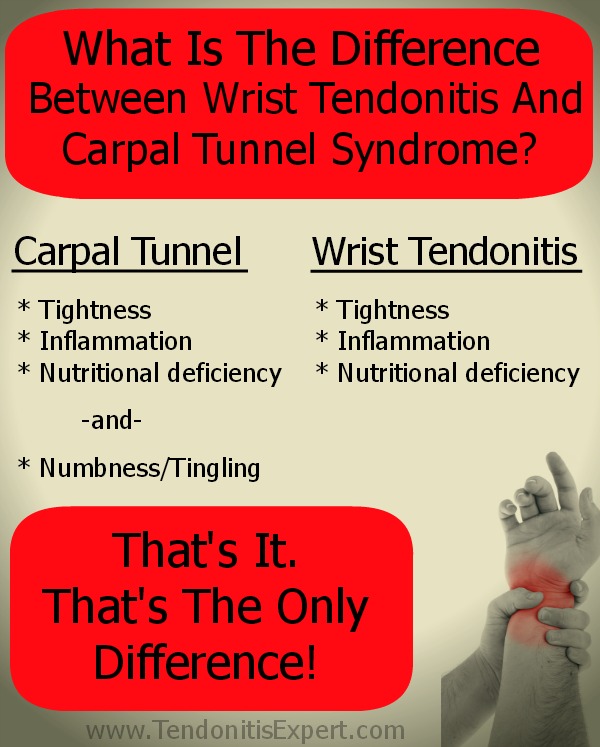Bone Bruise
Identify and Eliminate
What causes a bone bruise?
Punching hard objects, getting hit with a bat or a baseball, car crashes or getting kicked by a horse, any kind of impact has the potential to cause a bruising on the bone.
Whether the impact is directly to bone or the impact hits muscle and the force transfers through to bone, bone bruising is painful and long lasting.
A regular bruise goes away in a few days or weeks at most. Bruised bone can hurt for months or longer.
What Is A Bone Bruise?
A 'bone bruise is the pain and dysfunction caused by an impact.
For a regular bruise, impact causes capillaries in the skin and muscle (and spaces between, potentially) to burst. This is what causes the red and purple bruises.
Paintball bruises are from the sudden crushing impact of a high speed projectile.
That's 'normal' bruising, and that can be part of an overall bone bruise scenario.

Where a bone bruise differs from a regular bruise is that in a regular bruise, it's just skin and superficial tissue.
It takes a lot more force to cause a bruise to the bone IF there is fat and muscle in between.
In places like the shin bone, there's just skin over bone, so a lot less force is required.
In either case, impact crushes:
- Skin
- Connective tissue layer(s) between skin and muscle
- Muscle (if there's any there)
- More connective tissue
- Periosteum (the connective tissue that wraps bone)
- Bone
So, let's say you get kicked in one thigh by a horse (I got kicked by the young colt in the gut just under the bottom rib, mom got a full on hoof on each thigh from the momma horse....lucky me).
Instant pain, etc. In short order, there's visible bruising on the skin.
What you don't see is:
- bruising in the muscle and free blood in the interstitial layers
- Inflammation process trapping fluid in the area from periosteum to skin, and releasing pain enhancing chemical
- Periosteum swelling (and it really has no place to go)
- The Pain Causing Dynamic getting dialed up
- Bone swelling (and it REALLY doesn't have any place to go, it gets compressed by the periosteum, and pushes out against the periosteum, stretching it [painful]).
Bone Swells, Periosteum Traps It
Let's go over that part again, it's one of the more important aspects of the bone bruising dynamic.
- Bone, is hard, but is living tissue. It can shrink or expand. Direct impact makes it expand.
- The periosteum is like a tight skin on bone. Shrink wrap. Really tough stuff.
- When bone expands, it puts pressure on and tries to stretch that shrink wrap. This is and can be painful.
One of the reasons bone bruising hurts so bad and so long is because bone doesn't have that much natural circulation (it's hard bone, not soft squishy muscle or skin) so it naturally takes a long time to recover.
Thus, you have to help it along if you want the pain to go away faster than 'normal'.
How Do You Get A Bone Bruise?
The causes of bone bruising are endless:
- sports impact (kicked in shin, hit with a bat, getting tackled)
- car accident
- falling down
- punching a wall, accidentally hitting arm or leg on the corner of something
- etc, etc, etc
Anywhere you have bone, you can have bruising.
Anything that could possibly impact that bone (or get close to it with enough force) can cause bruising easily.
You can get hit with a bat in the head, the hand, the ribs, the legs, etc. Or a car. Or a horse. Or the edge of a table or counter.
Anywhere an impact can DIRECTLY hit bone, there will be a bruising response if the impact is hard enough to cause one.
There is INDIRECT impact too.
- Direct impact is impact directly onto bone (skin covered by bone)
- Indirect impact is impact to bone through fat and muscle, enough force pushes through bruise the bone and periosteum
A direct impact is something hitting directly on the bone.
An indirect impact is something hitting the body in a 'meaty' place like thighs or hamstrings or triceps, but there is so much force that the bone itself takes some of the brunt of the blow.
Ever been kicked in the thigh by a horse? I have. In that case you get a huge bruise and a long lasting bone bruise.
If there is muscle bruising, then there can be risks from a big/deep hemotoma, like:
- Myositis Ossificans (the loose blood turns to bone, basically)
- Blood clot
If there is bad/deep bone bruising, then there can be risks like:
- bone growth
- excess bleeding
But really, if injury to the bone is that bad, you'll be in an emergency room setting and will already have a follow up plan with a doctor.
The vast majority of bone bruises you can deal with yourself (because there's nothing for a doctor to do), either leaving it to time, or putting some effort in to speed things along.
*Note: Anytime there is a fracture or a broken bone, there is bone bruising.
Little Kids Can Get A
Bone Bruise Too
Kids fall off swings. They fall down stairs. They fall off beds. They run into table corners. They run into each other.
Luckily, kids heal fast, and they don't know any better. So things don't hurt long...and kids don't seem to complain too much anyway.
So most bumps and bruises are minor occurrences.
But when kids get in car crashes, or get hit HARD (by any number of possibilities), they get bone bruises too.
Fracturing and breaking bones causes bone bruises.
Again, with kids, for the most part you don't need to worry about it or do anything in particular. They recover fast and heal up just fine.
Make sure they have enough nutrition (and no I don't mean calories, I mean nutrients), they're growing fast and need all they can get.
In very traumatic instances or when you're willing to help your kind heal faster from the little things, then it's valuable to know how to help the body recover as fast as possible.
This will not only help reduce pain faster, but in the case of fracture/break, can improve healing outcomes.
How To Heal A Bone Bruise FASTER
Bone bruises heal slow.
Definitely slower than we want, but always slower than we would expect it to.
Guys that punch walls complain that they still have knuckle pain YEARS later. This isn't surprising when you've been around bruised bones for a while like I have (or if you've had a bad bone bruise before).
Here's the wall punching conversations: Long Term Hand Injury From Punching A Wall Hand Tendonitis And Knuckle Pain
Do you want to be hurting years later? I sure don't.
If you get kicked in the thigh by a horse, you have massive muscle bruising -and- bone bruise.
If you get kicked in the shin or whack your forearm bone on a counter top, it's just skin and bone, so just bruising of bone (and skin, though bruising doesn't always have to be visible).
Either way, by default they heal slow. And, you can make them heal faster.
Bruise pain in your bones is a very unenjoyable pain. And depending on the location, can keep a person from walking/moving very well.
Here's the Bruise Treatment you'll get from your doctor:
- Take Anti-Inflammatory drugs like Ibuprofen
- Rest
- Use an Ice Pack
That's pretty much it. Doctors really can't do much for bruising. In their defense, there's nothing medical to do for bruised bones.
The anti-inflammatories are fine to get you through the day, but they're not a long term strategy. And Ibuprofen and acetometophin have their own potentially dangerous downsides.
Rest, well, I usually am not a fan of rest but in the case of bone bruises, even when you help them along they take time.
Rest isn't a magical cure, so even if things hurt, you might as well keep moving. It's just pain, not damage (unless there is actual damage).
You'll even find that the more you move, the better it feels (probably). But then sit down for a while and get up again....ouch...that's some pain in bones right there!
How To Speed Up Bone Bruise Recovery
Bruised bones are a function of:
- Inflammation (trapped fluid and pain enhancing chemical)
- Compression
- Lack of good circulation to the area
So, if those are the factors keeping pain in place...what do you think you should do about that?
I think you should:
- Counter the inflammation
- Open up too tight tissue (as available)
- Create circulation (old stuff out, new stuff in)
If that's all I said, that'd be enough to go on. But I'll give you a little more.
Ice Packs
If you're going to use an ice pack, do it for 2-5 minutes on and then put it back in the freezer. Wait a little while and then do it again.
As many times as possible.
Using an ice pack for 20 minutes is a waste of 18-15 minutes.
Ice Dipping
Depending on the location, if you can, Ice Dip as many times as humanly possible for at least several days.
For Both, See: How To Reduce Inflammation
Hands On Massage
Icing creates circulation.
So does hands on massage.
Depending on the location of the bruise, this general description applies anywhere. Keep in mind that some spots are skin over periosteum over bone, and some are skin over fat and muscle over periosteum and bone.
- Rub around gently but as firmly as possible
- Squeeze tissue (muscle and skin)
- Gently/firmly press down towards/against the bone. You can't make it softer, but it's dense tissue (bone and periosteum shrink wrapping) and you need to gently force fluid to move through the tough tissue
Do this FREQUENTLY. Don't hurt yourself, but shoot for lots of repetition. You're squeezing a dry crunchy sponge trying to make it soft and squishy. Don't force it, take your time, but keep at it.
Again, icing and hands on massage creates circulation. This gets pain enhancing chemical out (so you hurt less) and new blood and nutrition in.
Hands on massage opens up too tight tissue, and creates circulation.
Be Patient, and Dilligent
Patience and dilligence is the moral of the story. There is NO quick fix to a bone bruise.
But, if you keep at it, you can take a three month thing down to a 2-4 week thing.
Some people don't mind hurting for long periods of time and limping along, but some other people want to get out of pain as fast as possible.
So get to work, and keep at it!
Return to the top of this Bone Bruise page.
Go to the www.TendonitisExpert.com homepage.



